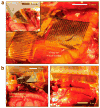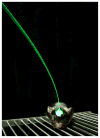Nanotools for neuroscience and brain activity mapping
- PMID: 23514423
- PMCID: PMC3665747
- DOI: 10.1021/nn4012847
Nanotools for neuroscience and brain activity mapping
Abstract
Neuroscience is at a crossroads. Great effort is being invested into deciphering specific neural interactions and circuits. At the same time, there exist few general theories or principles that explain brain function. We attribute this disparity, in part, to limitations in current methodologies. Traditional neurophysiological approaches record the activities of one neuron or a few neurons at a time. Neurochemical approaches focus on single neurotransmitters. Yet, there is an increasing realization that neural circuits operate at emergent levels, where the interactions between hundreds or thousands of neurons, utilizing multiple chemical transmitters, generate functional states. Brains function at the nanoscale, so tools to study brains must ultimately operate at this scale, as well. Nanoscience and nanotechnology are poised to provide a rich toolkit of novel methods to explore brain function by enabling simultaneous measurement and manipulation of activity of thousands or even millions of neurons. We and others refer to this goal as the Brain Activity Mapping Project. In this Nano Focus, we discuss how recent developments in nanoscale analysis tools and in the design and synthesis of nanomaterials have generated optical, electrical, and chemical methods that can readily be adapted for use in neuroscience. These approaches represent exciting areas of technical development and research. Moreover, unique opportunities exist for nanoscientists, nanotechnologists, and other physical scientists and engineers to contribute to tackling the challenging problems involved in understanding the fundamentals of brain function.
Conflict of interest statement
Figures







References
-
- Andrews AM, Weiss PS. Nano in the Brain: Nano-Neuroscience. ACS Nano. 2012;6:8643–8644. - PubMed
-
- Underwood E. Brain Project Draws Presidential Interest, but Mixed Reactions. Science. 2013;339:1022–1023. - PubMed
-
- A Frequently Asked Questions file is available for the Brain Activity Mapping Project. http://www.kavlifoundation.org/BAM.
Publication types
MeSH terms
Grants and funding
LinkOut - more resources
Full Text Sources
Other Literature Sources

